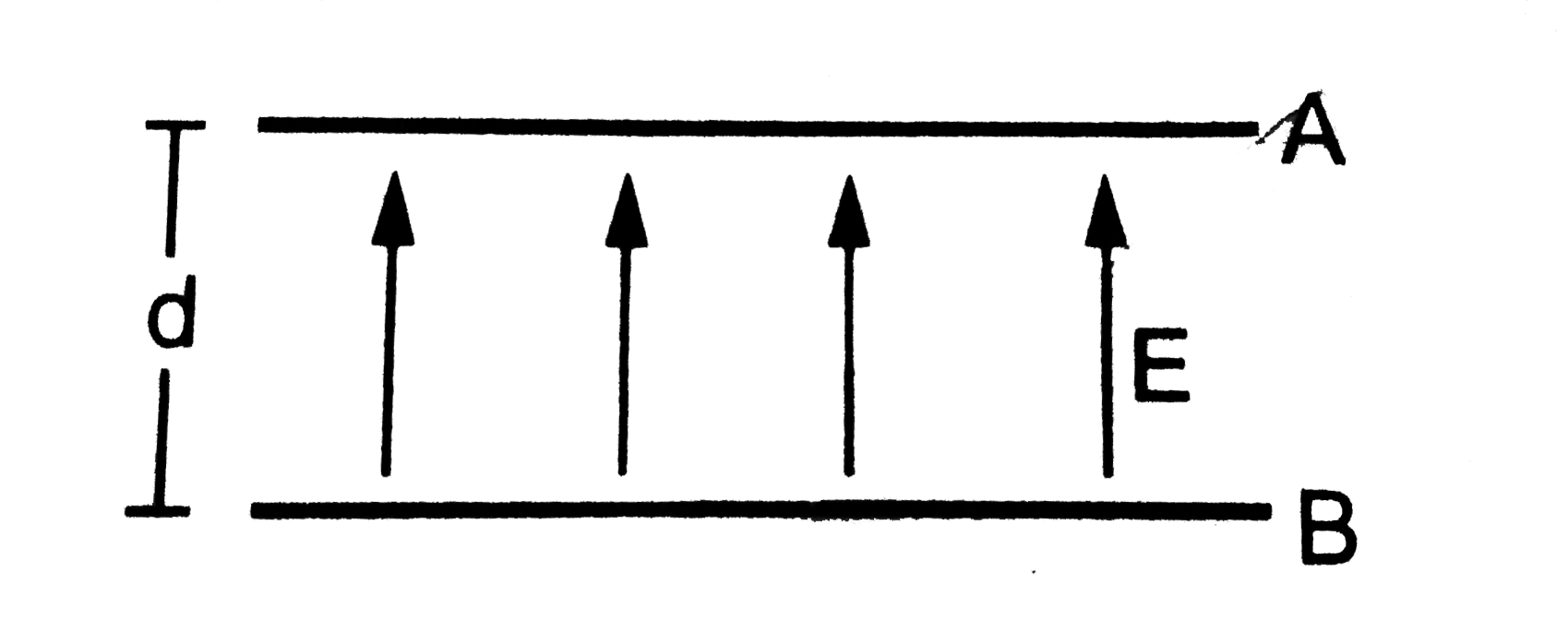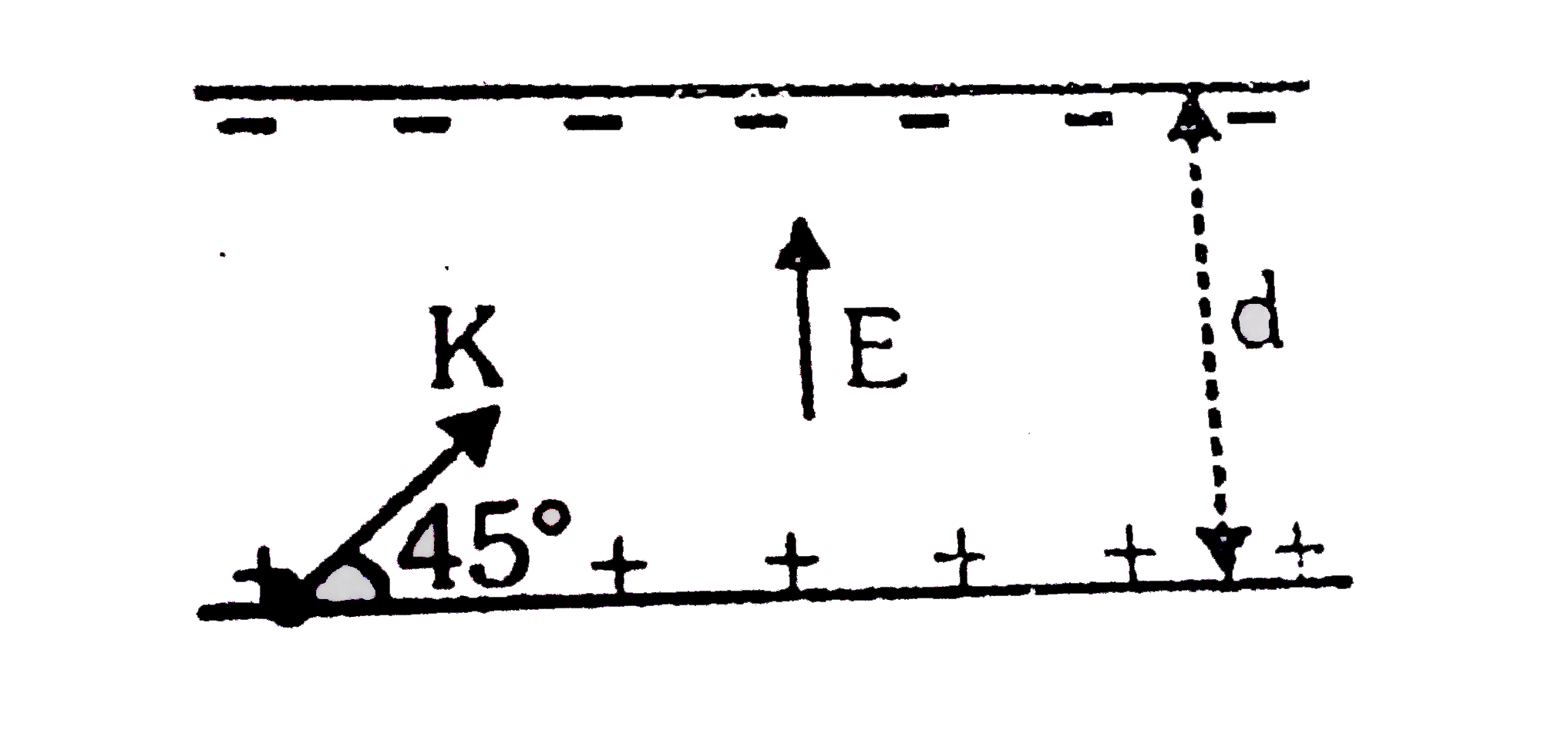An electric field of magnitude 1000NC−1 is produced between two parallel platees having a separation of 2.0 cm as shown in figure(29.E4) (a) What is the potential difference between the plates? (b) With what minimum speed should an electron be projected from the lower plate in the direction of the field so that it may reach the upper plate? ( c) Suupose the electron is projected from the lower plate with the speed calculated in part (b) . The direction of projection makes an angle of 60∘ with the field. Find the mazimum height reached by the electron.
 Solution in Tamil
Solution in Tamil
E=1000N/C
(a)dV=Edl=1000×2100=20V
(b)u=?,E=1000,s=2100m,
a=1.75×1014m/s2
0=u2−2×1.75×1014×0.02
⇒u2=0.04×1.75×1014
u=2.64×106m/s
Nowu=ucos60∘,v=0,s=?
−a=1.75×1014m/s2
v2=u2−2as
⇒s=0.497×10−2
=0.005m=0.50cm
Topper's Solved these Questions
- ELECTRIC FIELD AND POTENTIALBOOK - HC VERMACHAPTER - ELECTRIC FIELD AND POTENTIALEXERCISE - Objective 2
8 Videos
- ELECTRIC CURRENT THROUGH GASESBOOK - HC VERMACHAPTER - ELECTRIC CURRENT THROUGH GASESEXERCISE - Exercise
23 Videos
- ELECTROMAGNETIC INDUCTIONBOOK - HC VERMACHAPTER - ELECTROMAGNETIC INDUCTIONEXERCISE - EXERCISE
98 Videos
Similar Questions
Mart out the correct options
View SolutionA discharge tube contains helium at a low pressure. A large potential difference is applied across the tube. Consider a helium atom that has just been ionized due to the detachment of an atomic electron. Find the ratio of the distance travelled by the free electron to that by the positive ion in a short time dt after the ionization.
View SolutionCalculate the dimensions of (a) ∫→E.d→l,(b)vBlanddΦ0dt. The symbols have their usual meanings.
View Solutionshows two metallic plates A and B placed
. parallel to each other at a separaton d. A uniform
. electric field E exists between the plates in the direction
. from plate B to plate A. Find the potential difference
. between the plates.

View SolutionAn electron having charge e and mass m starts from the lower plate of two metallic plates separated by a distance d . If the potential difference between the plates is V , the time taken by the electron to reach the upper plate is given by .
View SolutionAn electric field E is produced between two parallel plates having a separation d as shown.
(a) With what minimum speed should an electron be projected from the lower plate in the direction of field so that it may reach the upper plate ?
(b) Suppose the electron is projected from the lower plate with the speed calculated in part (a). The direction of projection makes an angle of 60∘with the field. Find the maximum height reached by the electron.
(c ) After how much time , the electron again strikes the lower plate ?
(d) Horizontal distance travelled by the electron in time calculated in part (c).
Charge on electron : e ,mass of electron : m, consider only electric force.
View SolutionAn electron (e,m) is projected into a uniform electric field E vertically downward between parallel plates at separation d , with velocity v_(0) . The electron enters the electric field at a point midway between the plates. Find (a) the magnitude of electric field if electron emerges from the electric field just at the edge of upper plate. (b) the direction of the velocity of electron as it emerges from the electric field. (c ) the equation of trajectory followed by electron. The length of plates is L and consider only electric force.
View SolutionA potential difference of 500 V is applied across a paralle plate capacitor. The separation between the plates is 2×10−3m. The plates of the capacitor are vertical. An electron is projected vertically upwards between the plates with a velocity of 105m/a and it moves undeflected between the plates. The magnetic field acting perpendicular to the electric field has magnitude of
View SolutionAn electron is projected as in figure with kinetic energy K, at an angle θ=45∘ between two charged plates. The magnitude of the electric field so that the electron just fails to strike the upper plate, should be greater than:

View SolutionAn electron is projected with an initial velocity of 10^(7)ms^(-1) into an electric field between two parallel plates 1 cm apart. The electron enters the field at a point midway between the plates. If the electron just misses the positivity charged plate as it emerges from the field, find the magnnitude of the electric density between the plates. (Length of each plate is 2 cm, mass of electron= 9xx10^(-31) kg and charge of electron =1.6xx10^(-19) C)
View SolutionAn electron is liberated from the lower of the two large parallel metal plates separated by a distance of 20 mm. the upper plate has a potential of +2400V relative to the lower plate. How long does the electron take to reach the upper plate ? Take em of electrons 1.8×1011Ckg−1
View SolutionConsider the arrangement of parallel plates of the previous problem. If 1.0 nC charge is given to the upper plate instead of the middle, what will be the potential difference (in V) between (a) the upper and the middle plates and (b) the middle and the lower plates ?
View SolutionThe potential difference between two parallel plates is 10^(4) V. If the plates are separated by 0.5 cm, the force on an electron between the plates is
View SolutionAn electron of kinetic energy K is projected between two charged plats at an angle 60^(@) as shown in figure. If electrons doesn't reach to the upper plate just before striking then the magnitude of electric field will be more than:
View SolutionTwo long parallel plates A and B are separated by a distance of 4 cm with an electric field of 45 . 5 Vm^(-1) between the plates normally from plate A to plate B , as shown in the figure. An electron is projected from plate A with velocity v at an angle of 30^(@) with the surface of plate A . The maximum value of v so that the electron does not hit plate B is (Assume gravity free space, charge of electron = 1.6 xx 10^(-19) C and mass of electron = 9 . 1 xx 10^(-31) kg )
View Solutionदो समान्तर प्लेटों के विभव क्रमशः -10V एवं +30V हैं | यदि प्लेटों के बीच की दूरी 2cm हो | तो प्लेटों के मध्य विद्युत क्षेत्र होगा
View Solution
